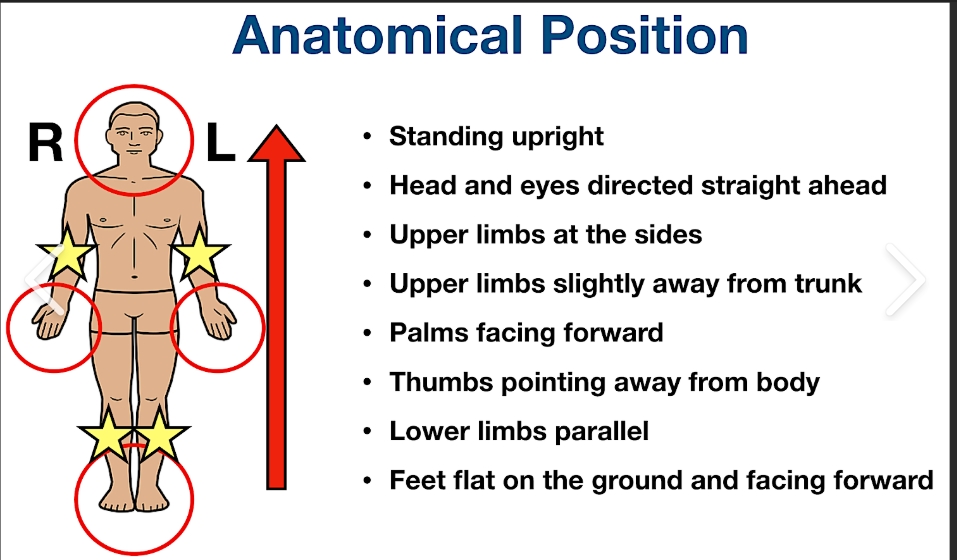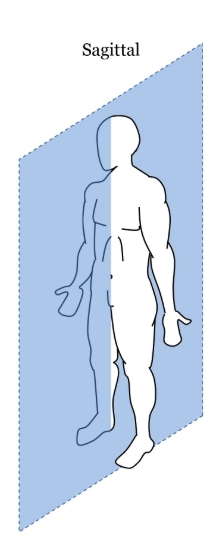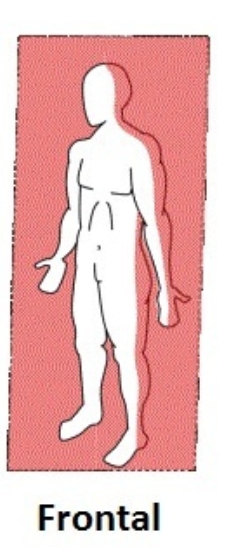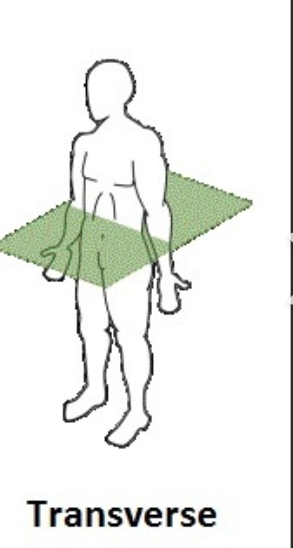Human Anatomy and Physiology- Teas Part 1
1/15
There's no tags or description
Looks like no tags are added yet.
Name | Mastery | Learn | Test | Matching | Spaced |
|---|
No study sessions yet.
16 Terms

Standard anatomical position
Terminology for direction and orientation on the body. In this position the person is standing with feet facing forward about hip width apart. Legs and torso are completely upright with their arms at their side. Both hands should have the palms facing forward.

Three Primary Body Planes; Sagittal/ Lateral, Coronal/Frontal, Axial/Transverse
Sagittal/Lateral Plane: Divides the body, or any body part, vertically into right and left sections. The sagittal plane runs parallel to the midline of the body.

Coronal/ Frontal plane
Divides the body, or any body structure, vertically into front and back (anterior and posterior) sections. The coronal plane runs vertically through the body at right angles to the midline.
Anterior: Front
Posterior: Back
Right angle meaning: The coronal plane divides the body vertically into front (anterior) and back (posterior) parts. It is perpendicular (at right angles) to the sagittal plane, which divides the body into left and right halves. Together, these two planes create four right angled sections.

Transverse/Axial/Horizontal Plane
Divides the patient’s body into imaginary upper (superior) and lower (inferior or caudal) halves.
superior: Above/ higher area
Inferior/ caudal: below/lower area
Terms of direction: Medial ( ears, toes, nose, eyes)
Means nearer to the midline of the body. In anatomical postion, the little finger is medial to the thumb.
Imagine standing straight with your palms facing forward (anatomical position).
Your little finger is closer to the center line of your body than your thumb is.
So, the little finger is medial compared to the thumb.
Think of it like this:
Middle of the body = midline
Anything toward that middle is medial
Anything away from the middle is lateral
Terms of Direction: Lateral (same as distal)
Opposite of medial. Refers to structures further away from the body’s midline, at the sides. In anatomical position, the thumb is lateral to the little finger
Terms of Direction: Proximal (limbs: arms, legs, hands, feet)
Refers to the structures closer to the center of the body. The hip is proximal to the knee.
Means closer to the center of the body — like your stomach and chest area (hips on up to shoulders).
Example: The hip is proximal to the knee because it's closer to the center of the body.
Terms of Direction: Distal ( limbs)
Refers to structures further away from the center of the body. The knee is distal to the hip.
Terms of Direction: Anterior
refers to structures in the front
Face
Chest (Pectorals)
Abdomen (Stomach area)
Thighs (front)
Knees
Shins
Palms of the hands (in anatomical position, palms face forward)
Toes
Terms of Direction: Posterior
Refers to structures behind
Back of the head (Occiput)
Shoulder blades (Scapulae)
Spine (Vertebral column)
Buttocks (Gluteal region)
Back of the thighs
Back of the knees
Calves
Heels
Cephalad and cephalic
Are adverbs (a word that describes or modifies a verb, an adjective, or another adverb. It often tells you how, when, where, to what extent, or how often something happens.) ex. She runs quickly.
(quickly tells how she runs — it modifies the verb*), meaning towards the head.
Use cephalad when talking about movement or direction toward the head.
Use cephalic when talking about something related to or located at the head.
“The instrument moved cephalad” is just a more precise, medical way of saying “The instrument moved toward the head.”
Cephalic vein:
The vein near the head or upper arm is called the cephalic vein.
(Here, “cephalic” describes the vein.)
Cranial
Is the adjective meaning of the skull. talking about or related to the skull — the bone that protects your brain.
Examples to make it real:
The cranial bones are the bones of your skull.
The cranial nerves are nerves that come from your brain and exit through holes in your skull.
The cranial cavity is the space inside your skull where your brain sits.
Caudad and Caudal
Caudad is an adverb (a word that describes or gives more information about:
a verb (an action word),
an adjective, or
another adverb. quickly
slowly
well
very
today)
Meaning towards the tail or posterior.
ex. In the sentence:
“The needle was inserted and moved caudad,”
the word caudad means toward the tail or lower part of the bod.
Caudal is an adjective
It describes something that is:
👉 Located near or related to the lower back, tailbone, or rear end of the body.
Example of how caudal is used:
Caudal vertebrae → the spinal bones near the tailbone.
Superior (height or vertical position (like higher or lower on the body),
Means above or close to the head
✅ CLEAR EXAMPLES: 1. The eyes are superior to the mouth.
Because the eyes are higher up on the face than the mouth.
2. The heart is superior to the stomach.
The heart is in the chest. The stomach is below it in the abdomen.
3. The nose is superior to the chin.
On your face, the nose sits above the chin.
Inferior (height or vertical position (like higher or lower on the body),)
means below or closer to the feet
. The feet are inferior to the knees.
Because your feet are farther down than your knees.
7. The bladder is inferior to the intestines.
The bladder is located in the pelvis, below the intestines.
8. The mouth is inferior to the nose.
The mouth is under the nose.
9. The pelvis is inferior to the stomach.
The pelvic region is below the abdominal region.
Summary of the terms of direction
Term | Think of it like... | Example |
|---|---|---|
Superior(up and down) | "Above" or toward the head | Head is superior to chest |
Inferior (up and dowm) | "Below" or toward the feet | Stomach is inferior to heart |
Medial (side to side) | Closer to your center line | Nose is medial to your eyes |
Lateral(side to side) | Farther from your center line | Ears are lateral to your eyes |
Proximal (limbs) | Closer to shoulder/hip (limbs) | Elbow is proximal to wrist |
Distal (limbs) | Farther from shoulder/hip (limbs) | Toes are distal to the knee |